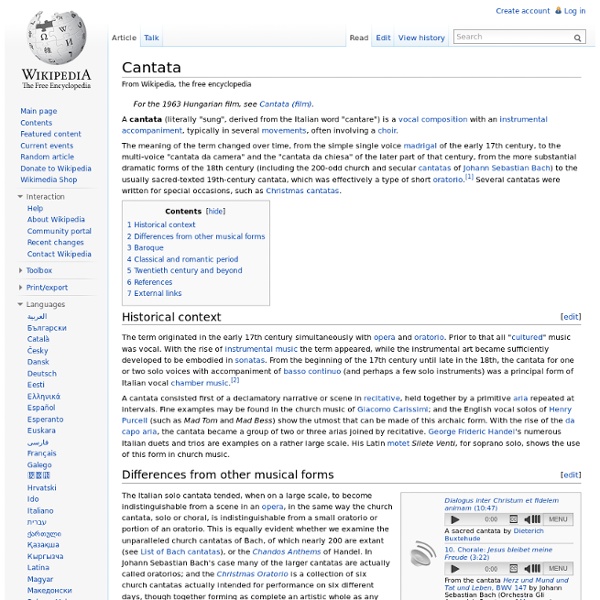Cantata

http://en.wikipedia.org/wiki/Cantata
The Cantata - Cantatas
Cantata comes from the Italian word cantare, which means "to sing." In its early form, cantatas referred to a music piece that is meant to be sung. However, as with any musical form, the cantata has evolved through the years.
Bach's Cantatas: A Brief Orientation
The story of Bach's cantatas begins with his first employment at the age of 18, in August of 1703, when he was appointed organist to the New Church in Arnstadt having recently dazzled the congregation with his brilliant performance at the dedication of their new organ. While his duties as organist did not require the composition of cantatas, Bach nevertheless produced some of his earliest choral works at this time, including Cantata 150: Nach dir, Herr, verlanget mich – Lord, my soul doth thirst for thee which is probably his earliest, and the Easter Cantata 4: Christ lag in Todesbanden - Christ lay by death enshrouded which he most probably composed as a test piece in 1707 when he successfully applied for the position of organist in Mühlhausen. 2. Mühlhausen 1707-1708: Cantata 71. Moving to Mühlhausen in July 1707, he remained there only a year, during which his position as organist again made no choral demands. 3.
Music History is Thrilling! » Baroque Cantata and Johann Sebastian Bach
Terms Cantata This vocal genre is usually based on a lyric or dramatic poem and could be either sacred or secular. It contains pieces for solo voices, chorus and instrumentalists in the manner of arias, recitatives and choruses.
Baroque sacred music - Cantata in the Lutheran Church
On with the sacred music of the Baroque. Previously we discussed the Oratorio as one big landmark of musical development. Now, the time has come to the
Related:
Cantata
Related:



